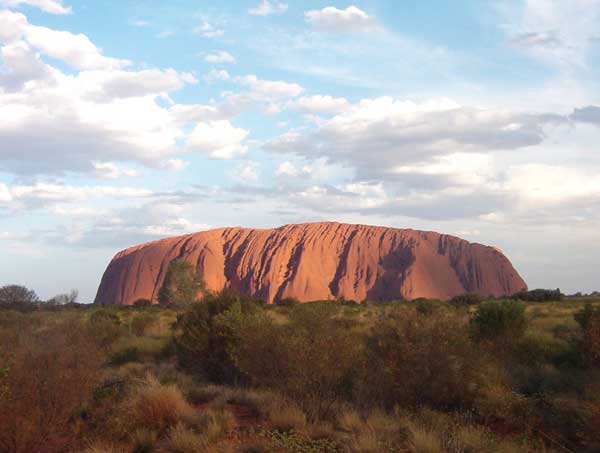 |
usa | world | animals | vocabulary | health | science | math | history |
Ayers Rock
Uluru (also Ayers Rock or The Rock) is a large rock formation in central Australia, in the Northern Territory. It is located in Uluru-Kata Tjuta National Park, 400 km southwest of Alice Springs. It is the second largest monolith in the world (after Mount Augustus, also in Australia), more than 318 metres (986 ft) high and 8 km (5 mi) around. It also extends 2.5 km (1.5 miles) into the ground. It was described by explorer Ernest Giles in 1872 as "the remarkable pebble".

Uluru at dusk
Uluru is notable for appearing to change colour as the different light strikes it at different times of the day and year, with sunset a particularly remarkable sight. The rock is made of sandstone infused with minerals like feldspar (Arkosic sandstone) that reflect the red light of sunrise and sunset, making it appear to glow. The rock gets its rust color from oxidation.
Uluru is sacred to the Aborigines and has many varied springs, waterholes, rock caves and ancient paintings. Ayers Rock was the name given to it by European settlers, after the Premier of South Australia Henry Ayers. Uluru is the name in a local Aboriginal language (Arrente), and since the 1980s has been the officially preferred name, although many people, especially non-Australians, still call it Ayers Rock.

Uluru, this time purple in the afternoon
The Aboriginal community of Mutitjulu (pop. approx. 150) is near the western end of Uluru. From Uluru it is about 21 km to the tourist town of Yulara (pop. 3,000), which is situated just outside of the National Park.
Kata Tjuta, which literally means 'Many Heads' owing to its peculiar formation, is another rock formation about 25 km from Uluru. They are called the Olgas by many Australians. Special viewing areas with road access and ample parking have been constructed in order to give tourists the best views of both sites at dawn and dusk.In 1980, baby Azaria Chamberlain disappeared while she and her parents were camping near Uluru. Her mother Lindy Chamberlain reported that Azaria had been taken by a dingo, sparking the most publicised trial in Australian history.
On 26 October 1985, the Australian Government returned ownership of Uluru to the local Aboriginal people, the Anangu (or 'people'), of the Pitjantjatjara tribe, who then leased it back to the Government for 99 years as a National Park, even though the government broke two of the promises they had made to them earlier.
The local indigenous community request that visitors respect the sacred status of Uluru by not climbing the rock, with signs posted to this effect.

Uluru, appearing yellow at midday
In 1983 the former Prime Minister of Australia, Bob Hawke, promised to respect the request from the community that climbing Uluru be prohibited, but broke his promise when title was handed to the Traditional Owners in 1985 because access for tourists to climb Uluru was made a necessary condition before they could receive the title. The climb crosses an important dreaming track, which has been a cause of sadness and distress among Traditional Owners.
Neverthless, they are unable, due to prohibit climbing, and climbing Uluru is a popular attraction for a large fraction of the many tourists who visit it each year. A rope handhold makes the climb easier, but it is still quite a long and steep climb and many intended climbers give up partway. There are several deaths a year as a direct result of climbing the rock, mainly from heart failure.
This article is licensed under the GNU Free Documentation License. It uses material from the Wikipedia article "Ayers Rock".